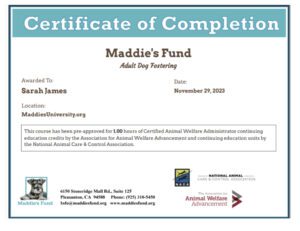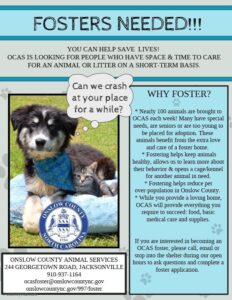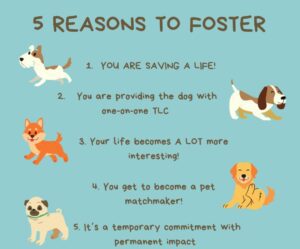Fostering
Introduction
Foster programs are great for shelters and for potential adopters. There is a lot of truth to the saying, “Fostering saves lives.” For animals who cannot handle the stress of shelters, fostering gives them a chance. Fostering presents a better picture of who an animal really is, so adoption matches can be more successful. However, fostering can be hard. It’s easy for a foster to feel overwhelmed and isolated at home with a challenging dog. It’s important to help them stay connected to the shelter/rescue and for them to know they are appreciated and supported. Fostering is a great PR program for any shelter or rescue. The families who foster will talk about your shelter/rescue and spread the word of the good work you do. They will become your advocates, your best volunteers, and a source of dedicated supporters.

Following are some tips to help in running a successful foster program:
Celebrate Your Fosters
Prioritize your foster caregivers. That means appreciating them in all your interactions. You can’t say thank you enough. Keep track of the number of animals placed with each foster home and shine a light on that foster when they reach significant numbers like 10, 25, 50, 100. Have a volunteer assigned to send congratulations/thank you cards to the foster, maybe give them a gift for each milestone (shelter/rescue sticker, magnet, t-shirt, etc.). Appreciation is what most people want more than anything else when they volunteer their time.
Create a Team of Foster Mentors
Recruit foster mentors from the shelter’s most experienced foster caregivers. These volunteers can assist other foster families by giving advice, helping with dog introductions, and training new fosters. This frees up the foster coordinator to work on growing the program and placing more dogs in temporary homes. Creating a closed communications group for foster volunteers provides a way for these caregivers to connect with one another and offer support and encouragement. For example, the Regional Center for Animal Care & Protection, VA set up a Facebook page specifically for foster volunteers to communicate with one another.
Cross-Train Current Volunteers to be Foster Caregivers
According to an Austin Animal Center booklet on creating a foster dog program, cross-training current dog volunteers to become fosters is good practice. These volunteers are dog savvy and already know the dogs making them great caregivers. Also, current volunteers likely have an emotional attachment to the dogs in need of fostering and will go the extra mile to help find them loving homes.
Cultivate Strong Relationships with Foster Caregivers
A survey of fosters conducted by the Austin Animal Center found that it was extremely important to foster caregivers that they had a strong relationship with the shelter staff. One of the most important aspects of this relationship for fosters was believing that shelter staff saw them as trusted members of the team working to help homeless animals.
Encourage Caregivers to Set Up Foster Facebook Pages
Private foster Facebook pages are a great way for caretakers to share information about their fostering activities and promote the dogs in their care via videos and pictures. Caregivers can also invite adopters to post updates on the dogs they’ve adopted from that foster home.
Encourage Volunteers to be Foster Friends
It’s easy for a foster pet parent to feel overwhelmed, especially if they have a challenging dog in their home. You can utilize volunteers who are not able to foster by assigning them to a foster as their “buddy”. The Foster Friend can support the foster by advocating for the dog, checking in with the foster to see if they need anything, acting as a go-between for the foster and the rescue/shelter, helping get the dog to adoption events, and supporting the foster through encouragement, a listening ear, and ideas for solving issues. Foster Friends will help retain fosters and make the experience a better one for all involved.
Fosters Can Provide Post-Adoption Support
Foster caregivers who agree to provide post-adoption support can offer assurance and support to adopters while they help a dog adjust to his/her new home. Having the support of a foster who knows the dog can sometimes prevent dogs from being returned to the shelter when adopters feel overwhelmed.
Foster Field Trips Offer so Many Benefits
At the Montgomery Humane Society, AL the Foster Field Trip program allows potential adopters to take a dog home for a few days or longer to see if he/she is a good fit. According to experts at Maddie’s Fund, field trips are quickly being recognized as a great way to find new foster caregivers, engage with the community, reduce kennel stress, and get better information on a dog’s behavior. Field trips are also helpful in marketing dogs for adoption, as potential adopters want to know what a dog looks and acts like outside of their kennel. The opportunity for creative photography, videos, and stories is increased during foster field trips. At the Montgomery Humane Society, the Foster Field Trip program has decreased the shelter’s return rate by 12 to 14 percent. Maddie’s Fund offers a pilot program template for shelters interested in launching foster field trip programs.
Highlight a Foster Volunteer Each Month
Make a big deal about the people who foster for your organization because they are a big deal and the key to increasing community engagement and raising awareness about the shelter. In all likelihood they are the shelter’s and the animals’ best advocates. Choosing a Foster of the Month provides an opportunity to highlight the foster caretakers in your organization’s newsletter, on social media, or even in the local paper. You can also create a tribute on a bulletin board or wall at the shelter. You might also want to acknowledge them with a thank you card from your board and a small gift card for a cup of coffee.
Invite Foster Families to Share Online Updates
 Sharing stories and photos of how well shelter pets are doing in their foster homes is a great way to showcase their personalities and help find them forever homes. Photos of foster dogs enjoying walks, playing or cuddling with other dogs in the household, and hanging out with human family members all help show what wonderful companions they will make.
Sharing stories and photos of how well shelter pets are doing in their foster homes is a great way to showcase their personalities and help find them forever homes. Photos of foster dogs enjoying walks, playing or cuddling with other dogs in the household, and hanging out with human family members all help show what wonderful companions they will make.
The Montgomery Humane Society, AL invites short-term fosters to participate in the shelter’s Adoption Ambassador Program. The purpose of this program is to provide shelter dogs with a break from the shelter and foster volunteers an opportunity to serve as ambassadors for the dogs they take home. Adoption ambassadors provide love, attention, and care to the dogs while promoting them on social media and taking them to local events to help find them forever homes.
Foster Friday Highlights at the Petersburgh County Animal Shelter shine a light on dogs in foster care through a pet profile and endearing images of the dogs with their foster families posted on social media.
Invite Fosters to Visit the Shelter
Encourage foster caregivers to bring their fosters to the shelter for nail trims and baths, or just to visit with staff so they can get to know them.
Keep Fosters in the Loop
Foster caretakers appreciate being kept up to date on the adoption process for their foster dogs. Let them know when there is an application, and connect potential adopters with foster caretaker to answer questions. Remember the caregiver is likely the most vested in finding the dog a home.
Launch a Foster for the Holidays Campaign
 There’s no place like home for the holidays, especially if you’re a shelter pet. Many shelters and rescue organizations run Foster for the Holiday campaigns in the weeks leading up to Thanksgiving. Some shelters ask fosters to commit to providing a safe, loving, and stable environment for foster pets from just before Thanksgiving to the end of the year. Others promote Thanksgiving Sleepovers asking that families keep foster dogs for just one week over the holiday. Spending time away from the shelter gives animals a chance to decompress and show their true personalities. This goes a long way in helping to find them forever homes in the New Year. One study found that “brief outings and temporary fostering stays increased dogs’ likelihood of adoption by 5.0 and 14.3 times, respectively.
There’s no place like home for the holidays, especially if you’re a shelter pet. Many shelters and rescue organizations run Foster for the Holiday campaigns in the weeks leading up to Thanksgiving. Some shelters ask fosters to commit to providing a safe, loving, and stable environment for foster pets from just before Thanksgiving to the end of the year. Others promote Thanksgiving Sleepovers asking that families keep foster dogs for just one week over the holiday. Spending time away from the shelter gives animals a chance to decompress and show their true personalities. This goes a long way in helping to find them forever homes in the New Year. One study found that “brief outings and temporary fostering stays increased dogs’ likelihood of adoption by 5.0 and 14.3 times, respectively.
Let Fosters Update Profiles
Give foster caregivers access to their foster dogs’ online profiles if at all possible. This saves you time and will mean you have current pictures and information on your dogs.
Make it Easy to Learn About Fostering
 Don’t make potential foster families have to work hard to learn about your program. Give information on fostering to every person who volunteers, adopts, donates, or interacts with the shelter in any way. Make it easy for them to sign up and respond immediately. You can also Host a foster information night that includes information on how to become a foster, in-person interviews, and ‘testimonials’ from current fosters. Bring in potential foster dogs to meet potential fosters.The Onslow County Animal Shelter invites the local community to attend Foster Rallies. Potential foster parents meet with program coordinators as well as the animals available for fostering. The rally allows plenty of opportunity for asking questions about how the fostering program works.
Don’t make potential foster families have to work hard to learn about your program. Give information on fostering to every person who volunteers, adopts, donates, or interacts with the shelter in any way. Make it easy for them to sign up and respond immediately. You can also Host a foster information night that includes information on how to become a foster, in-person interviews, and ‘testimonials’ from current fosters. Bring in potential foster dogs to meet potential fosters.The Onslow County Animal Shelter invites the local community to attend Foster Rallies. Potential foster parents meet with program coordinators as well as the animals available for fostering. The rally allows plenty of opportunity for asking questions about how the fostering program works.
Offer A Foster-to-Adopt Option
In an attempt to find loving homes for hard-to-place dogs, some shelters offer a Foster-to-Adopt option. As part of this program at the Redland Rock Pit Abandoned Dog Project, FL adoption fees are waived and potential adopters are invited to take a dog from the selected group home for two weeks to see if he/she is a good fit for the family. At Animal Harbor Animal Shelter, TN the Foster to Adopt program is a win-win for potential adopters and the dogs they take home for a trial period. The shelter describes it as being like a “dating period” to see if the shelter dog and his/her foster family would make a good forever match. During the foster-to-adopt period, adopters have access to the shelter’s foster coordinator and trainer who can answer questions or offer advice on any behavioral hurdles that may arise. Shelter representatives say the program is a great success and helps to keep shelter dogs in their new homes.
Offer Ongoing Support
Be available for training or behavior advice or assign a staff member or, better yet, a volunteer to be your foster coordinator to handle these things. You can also consider having dog-training classes for foster caregivers and their foster dogs with a local trainer.
Plan Foster Get Togethers
Set up ‘pack walks’ and playgroups for your fosters so that their caregivers can socialize, trade notes, support each other, and also socialize the dogs. You can also host social events and/or training sessions for your fosters to cultivate and educate your foster community.
Provide all of the basics
Provide food, treats, crates, and all the basic things foster volunteers will need. You can also encourage foster caregivers to create an Amazon wishlist just for fostering and include items they will need like dog beds, treats, toys, enrichment items, crates, and even food – receiving these from friends and family will save the shelter money.
Provide Continuing Education for Fostering Staff
 Invest in your shelter’s foster program by enrolling the Foster Coordinator or other staff or volunteer leaders in foster-related courses offered for free by Maddie’s Fund. Most recently, the nonprofit launched Camp Maddie: Foster Edition which covers all aspects of running a successful foster program. Presenters discuss breaking down barriers in the foster field, how to recruit foster caregivers, and provide insights into strategies they use to make fostering accessible in their communities.
Invest in your shelter’s foster program by enrolling the Foster Coordinator or other staff or volunteer leaders in foster-related courses offered for free by Maddie’s Fund. Most recently, the nonprofit launched Camp Maddie: Foster Edition which covers all aspects of running a successful foster program. Presenters discuss breaking down barriers in the foster field, how to recruit foster caregivers, and provide insights into strategies they use to make fostering accessible in their communities.
Puppy Sleepovers Can Help Get Dogs Adopted
Not all families can foster long-term but are happy to take puppies for sleepovers. At Hope for Life Rescue, VA puppy sleepovers range from an overnight to a few weeks. These sleepovers give puppies a break from the shelter, an opportunity to get individual attention, and more exposure on social media. All of this attention can help place the pup into a loving home sooner.
Reach out to Agricultural or Life Science Professors
If there’s a college campus near the shelter, reach out to see if it has an Agricultural or Life Sciences program. If yes, then the professors might be open to developing a foster program as part of the curriculum for students. For example, the Virginia Polytechnic Institute and State University launched the Paws for a Cause program. Students foster and work with shelter dogs from the Regional Center for Animal Care and Protection in Roanoke as part of a Shelter Dog Training course in the College of Agriculture and Life Sciences in the School of Animal Sciences. The students socialize, train, and work hands-on with 24 dogs over the semester. Students are paired with one dog for about a month on the college campus and help to find homes for the dogs at the end of their stay. In total, the course’s 46 students will work with three dogs over the course of the semester.
Recruit Foster Respite Volunteers
 Foster respite volunteers should be willing to be short-term fosters or babysitters providing a break for long-term fosters who need to travel. If you have a good list of short-term fosters, you won’t incur the expense of boarding when a family vacation or crisis requires you to find a place for a foster dog. Many people would love to foster but travel a lot or have other reasons they don’t want to commit to a foster full-time. This is a great way for just about anyone to foster for a day, a week, or an afternoon.
Foster respite volunteers should be willing to be short-term fosters or babysitters providing a break for long-term fosters who need to travel. If you have a good list of short-term fosters, you won’t incur the expense of boarding when a family vacation or crisis requires you to find a place for a foster dog. Many people would love to foster but travel a lot or have other reasons they don’t want to commit to a foster full-time. This is a great way for just about anyone to foster for a day, a week, or an afternoon.
Seek Out Weekend Warrior Fosters
Weekend Warrior Fosters take shelter dogs into their homes for the weekend. This is a great way to give a dog a break from the shelter while providing shelter staff with valuable feedback about how the dog acted in the home. This helps to find them the perfect forever family. Weekend volunteer fosters at the Shelter Volunteer Network-Newberry County, NC took their foster dog to visit the local Opera House. The dog wore pearls and a purple corsage, and met many new friends. What a fun way to market a shelter dog.
Share Health Protocols for Foster Dogs
Once a protocol for dewormings and vaccinations and been established share it with your fosters, along with the supplies to administer them, and/or schedule them to bring their fosters to the shelter for treatments. The more you can hand off to your foster, the more time the staff has for dealing with the dogs in the shelter.
Start a Seniors for Seniors Foster Program
Seniors for Seniors foster programs are designed to match senior citizens – typically 65 and older – with senior shelter dogs. This program gets older dogs out of the stressful shelter environment and places them into loving homes. It provides senior foster parents with loyal companionship, unconditional love, and a sense of purpose. Mature dogs typically have calm and gentle dispositions making them a perfect match for older foster parents. Many shelters run these programs in partnership with local senior centers. Shelters provide all the supplies the pets will need so there’s no financial burden on senior fosters. There’s also peace of mind because the shelter will take the dog back if circumstances change and the foster parent can no longer care for the pet. A Seniors for Seniors foster program coordinator should be chosen to run the program and manage a team of volunteers available to offer support. For example, volunteers can do drop-off visits delivering food and making sure that all is going well. They may also be called on to drive the foster dog to veterinary visits or the groomers. This program can be promoted on social media and a shelter representative can visit senior center events to do a presentation and bring along a senior shelter dog. Local media can also help promote the program. Once the program is up and running senior foster parents can help spread the word about the benefits of fostering older dogs.
Use Email Blasts to Stay in Touch with Foster Volunteers
Using email blasts or information manuals rather than handouts helps shelters share important information with approved fosters. The Big (and small) Dog Ranch Rescue utilized an email blast when seeking emergency fosters for small dogs leading up to Hurricane Milton. Be sure to include links to the shelter’s foster page for more information and to the online foster application form.
Veterinary Students Make Great Foster Parents
The Virginia-Maryland College of Veterinary Medicine has a wonderful Animal Care for Education foster program.  Students in the program work closely with dogs fostered from local shelters to improve their physical and mental health while helping the dogs develop social skills making them more adoptable. In return, the dogs help students learn clinical and behavioral training skills. Dogs are temperament screened before being enrolled in the program. When they leave the program they are spayed or neutered, vaccinated, and have learned basic obedience skills. At the end of the program, the college hosts a Meet and Greet with the canine instructors to help find them forever homes. Many of the Canine Instructors Class of 2023 graduates came from the Roanoake Regional Center for Animal Care & Protection, VA. If there’s a veterinary college in your community, it’s worth reaching out to see if they would partner with the shelter to foster shelter dogs. In addition to fostering animals, some veterinary colleges offer other support to shelters such as low-cost spay and neuter or help transporting animals.
Students in the program work closely with dogs fostered from local shelters to improve their physical and mental health while helping the dogs develop social skills making them more adoptable. In return, the dogs help students learn clinical and behavioral training skills. Dogs are temperament screened before being enrolled in the program. When they leave the program they are spayed or neutered, vaccinated, and have learned basic obedience skills. At the end of the program, the college hosts a Meet and Greet with the canine instructors to help find them forever homes. Many of the Canine Instructors Class of 2023 graduates came from the Roanoake Regional Center for Animal Care & Protection, VA. If there’s a veterinary college in your community, it’s worth reaching out to see if they would partner with the shelter to foster shelter dogs. In addition to fostering animals, some veterinary colleges offer other support to shelters such as low-cost spay and neuter or help transporting animals.
How to Recruit More Foster Homes
 If your shelter or rescue is having trouble recruiting foster families, the following tips may help you find new volunteer caretakers.
If your shelter or rescue is having trouble recruiting foster families, the following tips may help you find new volunteer caretakers.
• The result of research conducted by Maddie’s Fund shows that the organizations with the biggest foster programs have quick and easy onboarding processes. Shelters and rescues that require things like home, landlord, and veterinarian checks result in much smaller foster programs. Successful foster-based rescues report to Maddie’s Fund that their quick, easy foster care application process helps them to recruit dedicated and compassionate foster parents.
• Word of mouth is one of the most effective ways to recruit new volunteers. Encourage your current foster and volunteer base to reach out to friends and family and let them know that the shelter needs foster caregivers and the positive impact foster homes play in the lives of shelter pets. Purr Nation Cat Alliance encourages foster volunteers to post sign-up information on the nonprofit’s behalf on Nextdoor, the free neighborhood network app.
• Make sure that visitors to the shelter’s webpage can easily find information about fostering pets. Provide an easy-to-find link to an online foster application form. Maddie’s fund provides a valuable list of best practices when promoting your foster program online.
• Don’t turn away potentially great foster caregivers with unnecessary requirements. For example, only accepting foster applicants with previous breed experience, those who work from home, or those who have fenced-in yards can really limit the number of applicants who qualify for your program.
• Be sure that the importance of foster care in your shelter and rescue is being communicated as often as possible in newsletters, on social media, and in news releases. Highlight pets in foster homes and mention how well they are doing.
• Keep educating your local community about the huge role foster families play in helping shelter pets find new homes. Explain how foster homes help reduce stress levels, encourage pets to become more trusting of humans, expose pets to living in a home making it easier for them to adjust to a new family, and reduce their exposure to germs that may be found in a crowded shelter environment.
• Target recently retired people or empty-nesters to become foster caregivers. Often retirees have time on their hands and are actively looking for volunteer opportunities. For empty-nesters whose kids have recently moved out the house taking care of a foster dog may help to fill a void.
• Think outside the box when it comes to finding new foster caregivers. For example, the Santa Cruz County Animal Shelter posts “Need a Workout Buddy? Foster a Shelter Dog” fliers at popular hiking trailheads. What a great way to grab the attention of walkers who may be looking for walking buddies but not ready to commit to permanent adoptions.
• The Friendly Finders Program at the Montgomery Humane Society, AL encourages good Samaritans who find lost pets to foster them in their homes for a few days while the shelter works to find their owners. The shelter pays for food and supplies and the friendly finder helps in posting fliers around the community and uploading photos to missing pets websites. At the end of four days if no owner has been found, the good Samaritan can continue fostering or bring the pet to the shelter.
The Many Benefits of Fostering Shelter Pets

Fostering a homeless animal is a wonderful way to help shelters when you’re not in a position to adopt. Following are the many benefits of fostering a shelter pet courtesy of the SPCA of Bradley County, TN.
- Foster pets learn they’re loved and get to experience more about life in a new home.
- Fostering saves lives by creating much-needed space in the shelter for pets who have no other place to go.
- Some pets get very stressed in the shelter environment and foster homes offer them a place to relax and stay healthy.
- Fostering offers flexibility and a temporary way to have a pet in your life.
- Caring for a foster animal can help you heal after the loss of a pet.
- Foster pets have a way of bringing smiles and laughter into their foster homes.
- If you fall in love you always have the option to adopt your foster pet.
Click Links for More Resources
• Resource Guide
• Advocacy
• Community Outreach & Education
• Fostering
• Fundraising
• General Resources & Programs
• Grants
• Holidays – Shelter & Animal-Related
• Kids 4 Paws
• Marketing Your Dogs
• Shelter Programs & Enrichment Ideas
• Volunteer Programs & Practices
• Other Useful Shelter/Rescue Information